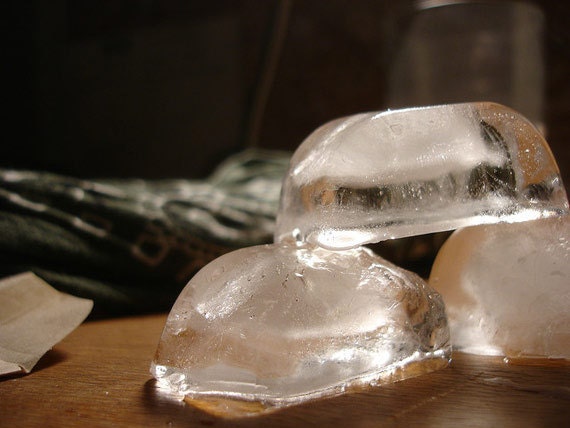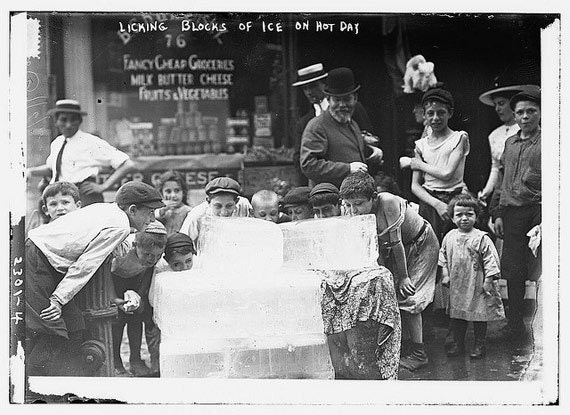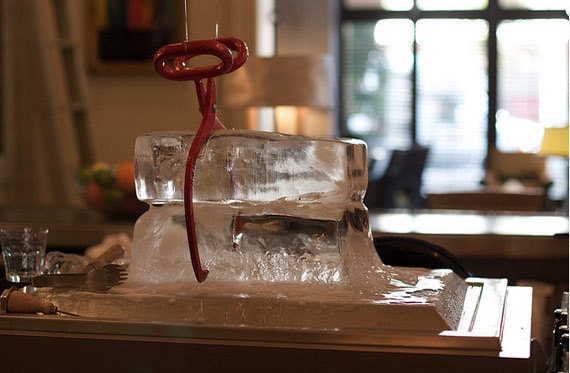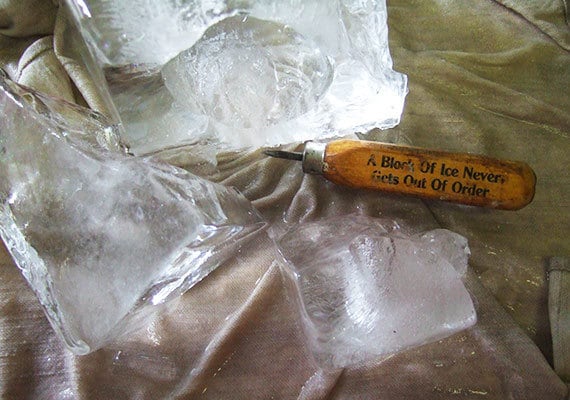An attempt to use this simple tool reveals getting the perfect chip off the old block involves quite a bit of skill.

Sarah Lohman is a historic gastronomist. She recreates historic recipes as a way to make a personal connection with the past, as well as to inspire her contemporary cooking. You can follow her adventures on her blog, Four Pounds Flour. In this series, Lohman will comb Etsy for items that speak to America’s culinary past. The Kentucky Derby has come and gone, and it marks the one day a year most drinkers will consume a mint julep — a heavenly blend of bourbon, sugar and mint with lots of crushed ice. But for me, the Derby marks the beginning of Mint Julep Season. A sweet, icy julep is the best way I know to beat the heat on a sultry summer evening. Of course, sometime towards the end of June, Julep Season blossoms into Mojito Season — and sometime during the hottest days of August, Mojito Season gives way to Something-on-the-Rocks Season. The key to all of these drinks is not which liquor you prefer, but the ice. I started thinking about the importance of ice after outfitting my home bar with a vintage ice pick from Etsy. The concept of iced drinks goes back thousands of years: in the ancient Middle East, snow was brought down from mountains and mixed with sweetened, flavored syrups. The Romans diluted wine for consumption by mixing it with snow. In the United States, the first thing we called a cocktail — a combination of spirits, sugar, bitters, and water — was served at room temperature. Around the turn of the 19th century, we began cooling our alcoholic beverages with ice.
 Indulging%20in%20ice%20on%20a%20hot%20day.%3Cp%3E%3Ca%20href%3D%22http%3A%2F%2Fwww.flickr.com%2Fphotos%2Flibrary_of_congress%2F2162948501%2F%22%20target%3D%22_blank%22%3ELibrary%20of%20Congress%3C%2Fa%3E%3C%2Fp%3E
Indulging%20in%20ice%20on%20a%20hot%20day.%3Cp%3E%3Ca%20href%3D%22http%3A%2F%2Fwww.flickr.com%2Fphotos%2Flibrary_of_congress%2F2162948501%2F%22%20target%3D%22_blank%22%3ELibrary%20of%20Congress%3C%2Fa%3E%3C%2Fp%3ECut from lakes and ponds and stored in well-insulated icehouses, ice could last from the final snow of spring until the first snow of fall. As the ice industry grew in the 1900s, so did its presence behind American bars. The ice would have been brought into bars in blocks and skillfully chopped apart by the resident bartender into a single, large chunk to float in the center of a punchbowl; in lumpish cubes, to cool a cocktail; or “rasped,” shaved into a fine snow to instantly dilute a summer drink sipped through a straw. The advent of the home freezer — and the ice cube trays that were sold with it — put an end to the ice-block industry in the 20th century. But today, there’s an ice revival. Step in to any high-end cocktail joint and you may spot a crystal clear ice block glistening on the back bar. I remember being astounded at the clarity and quality of the ice in my glass while drinking at Boston's Stoddard’s Fine Food and Ale: the jumbled cubes were like rock diamonds. It sounds silly, but it was gorgeous. The ice is also cut to a size that properly dilutes each drink.
 An%20ice%20block%20used%20to%20make%20cocktails%20in%20a%20bar.%3Cp%3E%3Ca%20href%3D%22http%3A%2F%2Fwww.flickr.com%2Fphotos%2Fmeriko%2F2944144822%2Fin%2Fphotostream%2F%22%20target%3D%22_blank%22%3EMeriko%20Borogove%3C%2Fa%3E%3C%2Fp%3E
An%20ice%20block%20used%20to%20make%20cocktails%20in%20a%20bar.%3Cp%3E%3Ca%20href%3D%22http%3A%2F%2Fwww.flickr.com%2Fphotos%2Fmeriko%2F2944144822%2Fin%2Fphotostream%2F%22%20target%3D%22_blank%22%3EMeriko%20Borogove%3C%2Fa%3E%3C%2Fp%3EBeing a home cocktail enthusiast, I thought my vintage ice pick would be the perfect addition to my bar. I imagined myself hosting cocktail parties, and instead of fumbling with large bags of corner-store ice, I would deftly chop glittering cubes off an ice block to impress my guests. The wood-handled pick had the perfect look to match my style: a promotional item from the National Ice and Cold Storage Company of California, a company around during the first half of the 20th century, it promised in bold black letters that “A Block of Ice Never Gets Out of Order.” You know when you think something is going to be really easy, and then you realize you're in way over your head? I first got that feeling after watching Japanese ice ball carving videos online; it dawned on me that I was destined to puncture my hand.
 Sarah%20Lohman
Sarah%20LohmanTo start, I filled a large, square plastic container with tap water and froze it overnight. I thawed it and smacked the bottom against my countertop to dislodge air bubbles. I froze it again, and then unmolded a semi-clear block of ice. I began hacking away at my ice block, but I wasn’t producing anything close to usable ice chunks; instead, I was simply making a big mess. Ice chips flew all over me, the kitchen floor, the cat, and the living room couch, then melted into messy puddles. Although I could visualize myself deftly carving off cubes of ice, it just wasn’t happening. I decided to try to carve off a large chunk of ice. Using a hammer and a flat head screwdriver, I tried to score a large cube from a corner of the ice block; it shattered into a triangular chunk. I attempted to use my ice pick to chip the triangle into a sphere. I ended up with a piece of ice roughly the size and shape of a smashed goose egg. By this point the counter and floor were covered with a growing pool of icy water. This block of ice was out of order! I instantly gained a monumental respect for the nimble bartenders who had instantly and skillfully filled my glasses with gorgeous ice gems. Determined to cut my losses, I gathered up the chips of ice, stuffed them into a glass and made myself a cocktail.
 Sarah%20Lohman
Sarah%20LohmanGin Fizz Punch Inspired by the “Sloe Gin Fizz” from Sloppy Joe’s Bar Cocktails Manual, 1932 I love gin in a summer cocktail. If you think you don’t like gin, try an American gin; they tend to tune down the juniper (pine) flavors and focus more on citrus. I love locally produced Brooklyn Gin, and this drink is also exceptional with Averell Damson Gin Liquor, a gin infused with the juice of damson plums. The juice of one lemon (about 2 tablespoons) 1 teaspoon sugar (or simple syrup) 1 oz strong green tea 1 oz gin 1 oz seltzer Fill a tumbler with ice. Add the first four ingredients and stir. Top off with seltzer.



